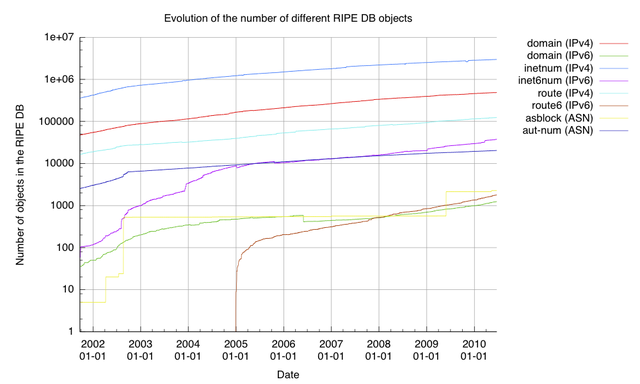This graph shows how the number of various RIPE Database objects evolved over time, in particular domain, intenum, route and aut_num objects.

The graph above shows how the number of different RIPE DB objects evolved over time. It only shows "operationally important" object types for now, but we are planning to add persons, roles, and the rest a bit later.





Comments 3
Comments are disabled on articles published more than a year ago. If you'd like to inform us of any issues, please reach out to us via the contact form here.
Anonymous •
<div class="content legacycomment"> <p> The discontinuity in the graphs drew my attention. Like... the number of asblocks went from something like 500 to 2000 overnight. </p> <p> </p> <p> It will be interesting to see what happens with inetnum objects after IPv4 exhaustion. Will we see fragmentation of address space resulting in more of these, or consolidation resulting in less? Or neither, as everyone moves to IPv6 overnight? ;) </p> </div>
Hide replies
Anonymous •
<div class="content legacycomment"> <p> Last year IANA updated their lists of blocks of AS Numbers assigned to which registry. They took into account the early registration transfers (ERX) that have happened over recent years. For each ERX, a previous contiguous block of assignments became three assignment blocks. Even if it was only one single AS Number in the middle of the block that had moved. The RIPE NCC then re-synchronised the RIPE Database with this new information. Then as you pointed out, overnight there was a big increase in the number of AS-BLOCK objects. </p> </div>
Anonymous •
<div class="content legacycomment"> <p> There is a proposal right now within the RIPE PDP, 2010-02, Allocations from the last /8. </p> <p> We have published an Impact Analysis just recently, and part of it is about fragmentation that is anticipated as an impact of this proposed policy. The analysis reads the following: </p> <p> </p> <p> "...Compared to the current global routing table statistics as reported in <a href="http://www.cidr-report.org/as2.0/"> <u> http://www.cidr-report.org/as2.0/ </u> </a> , the number of prefixes would go up by 5% when all 16,384 allocations have been handed out. This growth could come in two stages. In the first stage we could see a rapid increase in a relatively short time when the threshold of the last /8 is reached and existing LIRs matching the criteria each apply for a /22. In the second stage, we could see the extra growth happen more gradually while new entrants join the RIPE NCC and apply for their /22 of IPv4..." </p> <p> </p> <p> [The equivalent of a /8 will accommodate 16,384 allocations of a size /22, which is the allocation size proposed in 2010-02] </p> <p> </p> <p> You can find the full proposal and the analysis at: </p> <p> <a href="http://www.ripe.net/ripe/policies/proposals/2010-02.html" title="http://www.ripe.net/ripe/policies/proposals/2010-02.html"> http://www.ripe.net/ripe/policies/proposals/2010-02.html </a> </p> <p> </p> <p> Filiz Yilmaz </p> <p> Policy Development Manager </p> <p> RIPE NCC </p> </div>